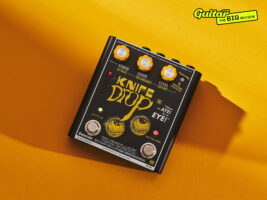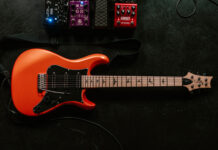
Eventide Third Man Hardware Knife Drop review – “This Jack White pedal is outrageously great fun”
£299/$299, thirdmanrecords.com
It feels like a long time since Jack White shook up the world of guitar with little more than a Big Muff, a DigiTech Whammy and a generational amount of guitar talent. In recent years, White has used his Third Man Hardware brand to ensure that the man never has to use a non-black-and-yellow pedal, amp or guitar ever again.
READ MORE: TC Electronic Plethora X1 review – probably the most powerful compact effects pedal ever made
All of this is to say it’s quite understandable if you’re getting Jack White fatigue of late. Last year saw him launch no less than five new signature products – including a massively hyped signature Fender guitar and amp, a very unexpected budget multi-effects, a DIY pedal kit, an analogue spring reverb and, right at the end of 2024, this pedal you see before you.
And at a distance, yeah, it’s very easy to wonder if he’s just doing it for the sake of it at this point – doing collab drops for the sake of it like he’s Nike trying desperately to get people excited about Dunks again.
But then you play the damn things, and you quickly realise that none of these pedals are just being done because he can – they’re invariably fun, surprising and musically exciting boxes that do something slightly different to anything else out there.
And this collab with Eventide? The wonderfully named Knife Drop? It might just be the most outrageously fun pedal White has put out yet.
Image: Adam Gasson
Eventide x Third Man Hardware Knife Drop – what is it?
What’s your favourite Jack White guitar tone? For me this question is very much like picking your favourite child, such is Jack’s quarter-century commitment to creating glorious guitar sounds. If I’m honest, it’s probably at 01:48 of Ball And Biscuit where he explodes into a barely contained squall of fuzz and noise… but my second favourite is the synth-octave masterclass that is pretty much all of Blue Orchid.
The most important thing you should take from this review is that the Knife Drop is, basically, that. It’s Blue Orchid in a pedal, and this, for certain people (hi!), would be worth $299 on its own.
But what does that mean in practice? Well, like Blue Orchid what you have crammed into this very fun little box is a bunch of different sounds derived from White’s personal favourite bits of Eventide’s all-conquering H9 multi-effects. So of course you get fuzz, but going into that you also have a monophonic synth, and the option to add high or low octaves, oh and there’s a filter in there too.
What happens is thus – the incoming guitar signal is blended with a monophonic analogue-style synth, the amount of which you can control with one of the three knobs on the top of the pedal. Next, that signal is fed into the drive stage, which runs the gamut from sleazy raunch all the way up to a spitty, gated fuzz. You can then run all that into a footswitchable octave control, which is either octave up or down, and can be triggered by the second footswitch.
Using the alt function of the three top-mounted knobs you can also determine the attack, resonance and cutoff of the filter – which can be placed either before or after the distortion stage.
Also on board are a bunch of Jack White-created presets, which are indicated by the ‘LED ladder’ on the front of the pedal, and the specifics of each are represented by a fun old-school card that slots over the top of the knobs like some sort of 1980s electronic board game. This being an Eventide pedal you also get stereo out (via a TRS stereo jack), full MIDI control and expression pedal/external footswitch operation. You can also get deep into the editing weeds courtesy of Eventide’s H90 Control app.
Image: Adam Gasson
Eventide x Third Man Hardware Knife Drop – usability
If all the talk about app control and MIDI presets has you reaching for the emergency stop button on this particular train ride, hold fire – while there’s obviously a lot of depth you can get into with this unit, pretty much everything that you need to make an extremely exciting noise is contained right here on the pedal itself – though it’s perhaps not the most intuitive thing I’ve ever come across.
That’s because in order to access the alternate functions of the three onboard controls – which lets not forget tweak the fairly important attack, resonance and cutoff of the filter sound – can only be accessed by holding down the ‘alternate endings’ button and then twiddling the respective knob. In practice, this is a two-handed job, meaning that adjusting on the fly is going to involve more than just an artful nudge with the edge of your shoe or a quick lean-down mid-song.
Of course, this sort of faffing won’t be a problem if you have all your settings saved to one of the onboard presets – but that’s another annoying wrinkle on the usability side. In order to access any of the presets, or switch between them, you’ll need to hook it up to an external footswitch or MIDI. There’s no mention of this anywhere in the manual – I ended up on a Reddit thread to confirm what appeared to be the case – meaning that unless you happen to have a secondary switch handy like I did, or be a paid up member of the MIDI-controlling club, you’ll have to fork out another $50-100 bucks just to access one of the most useful features of what is already a pretty pricey pedal.
Most disappointingly of all, this also applies to the onboard Jack White-created presets – given that they’ve gone to the trouble of creating very fun old school settings cards that slot over the top of the pedal to indicate where you should set the knobs for each preset, the fact that you can’t actually use them out of the box is really frustrating.
The bizarre thing is that you can save a preset from the pedal itself – by pressing and holding both footswitches simultaneously – and that seems like an absolutely baffling decision in retrospect. Surely that function would have been better served for cycling through the stored presets (the pedal already has an LED indicator to show you which one you’re on!) and then use another combo (perhaps holding down the ‘alternate ending’ button alongside a footswitch press) to save a new one? There’s a USB-C port on the back of the unit for firmware updating… Eventide, it’s not too late to fix this.
Image: Adam Gasson
Eventide x Third Man Hardware Knife Drop – sounds
A confession – I am a stickler for good user experience, and nothing will throw the vibe off when I’m reviewing a new pedal than finding that it has an annoying flaw that gets in the way of you simply enjoying the thing. I say the above to emphasise the fact that it takes roughly four seconds after plugging the Knife Drop in to absolutely forget about everything I wrote in the usability section because, reader, this thing is outrageously great fun.
Too often, guitar synth pedals are polite and well-mannered – trying to offer guitar players the smooth and composed experience of a real synthesizer without having to do anything as unpalatable as buying something with keys on it. The Knife Drop is, emphatically, not well-mannered in any sense of the term. It is positively uncouth in the most authentically Jack Whiteian way.
It’s immediately apparent that picking dynamics play a big part in how unruly this thing is – the harder you dig in, the wilder it will get. This is extremely important when you turn up the drive and engage the upper octave – it’s a wild Blue Orchid-type sound but somehow even less restrained and more prone to explosions of noise and glitching. Mercifully, the built-in noise gate at least tames this when you’re not playing so you won’t go into cacophonous noise unless you really want to.
Where you choose to put that drive in the signal path also has a massive impact on the sound – putting it up front will generate a sound that’s more recognisably a guitar, with the filter and synth elements playing more of a supporting role, while flipping them around has a more bit-crushed electronic timbre overall.
The low octave sounds are also a very different vibe – especially if you roll back the attack knob to make the effect bloom more gradually. The way the synth throbs away underneath the fretted notes is supremely enjoyable and hits all the right Tron soundtrack buttons in my brain.
Image: Adam Gasson
Eventide x Third Man Hardware Knife Drop – should I buy one?
I’ve had to somewhat skip over the sheer depth of sounds on tap above because honestly there are so very many different sonic options that you can uncover by putting together the constituent bits together in different ways. It’s a reminder that while the temptation is to pigeonhole this as a Jack White octave fuzz/synth sound generator, it’s capable of a huge amount more than imitating some classic White Stripes tones.
There are issues with the usability for sure, and it’s disappointing that more thought wasn’t put into serving the onboard White-created presets to the user out of the box because each of them sounds fantastic, but those tend to rapidly recede when you find yourself having this much fun. It’s certainly not for everyone, and it’s most definitely not polite – but the Knife Drop makes its extremely sharp point as soon as you hit the first note.
Eventide x Third Man Hardware Knife Drop – alternatives
If you want some gloriously gnarly fuzz and synth without the octave stuff getting in the way, then the Keeley Synth-1 ($179/£189) offers a bunch of wave-shapes and loads of fun for a fairly reasonable outlay. If you gotta have some octave in with your synth, the EarthQuaker Devices Bit Commander ($199/£199) is another gnarly compact box. Finally, if you want a truly elite guitar synth pedal Meris’ Enzo ($299/£349) is perhaps one of the most ‘sit down with this and you’ll spend four hours sitting there making fun weird noises without even noticing the time has passed’ pedals ever made.
The post Eventide Third Man Hardware Knife Drop review – “This Jack White pedal is outrageously great fun” appeared first on Guitar.com | All Things Guitar.
Source: www.guitar-bass.net













